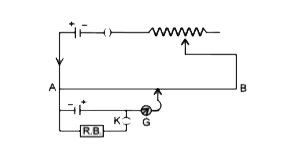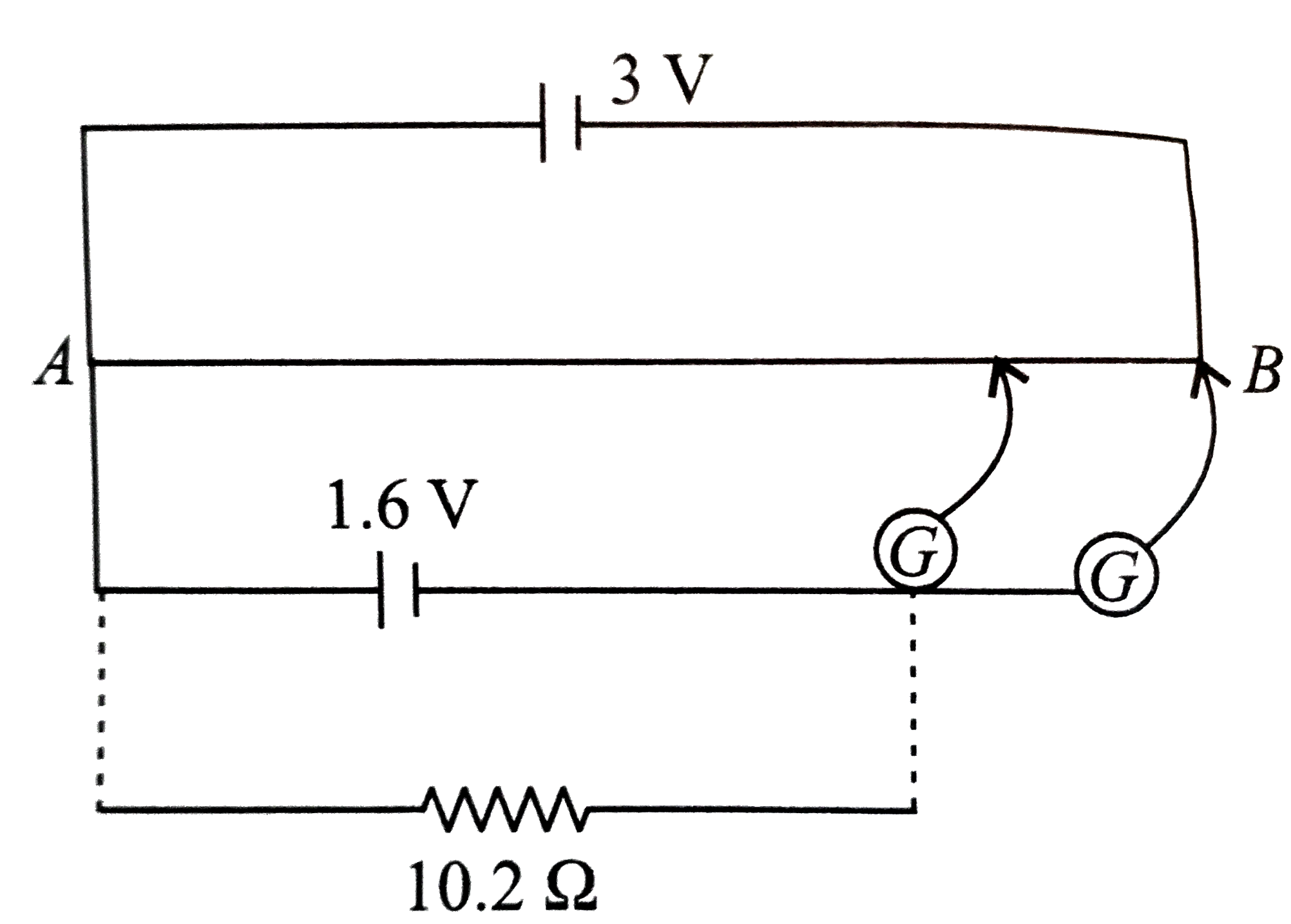Correct diagram for the determination of internal resistance of a primary cell by potentiometer



None of the above
The correct Answer is:B
To determine the internal resistance of a primary cell using a potentiometer, we can follow these steps to set up the correct circuit diagram and understand its functioning:
1. Understand the Components:
- Identify the components needed: a primary cell (whose internal resistance we want to measure), a potentiometer, a galvanometer, a known resistor (external resistance), and a battery.
2. Connect the Circuit:
- Connect the positive terminal of the primary cell to one end of the potentiometer wire.
- Connect the negative terminal of the primary cell to the negative terminal of the battery.
- Connect the positive terminal of the battery to the other end of the potentiometer wire.
3. Insert the Galvanometer:
- Connect the galvanometer in parallel with the potentiometer wire. This will help in detecting the null point where no current flows through the galvanometer.
4. Add the External Resistance:
- Include a known external resistance in series with the primary cell. This will allow us to measure the current flowing through the circuit.
5. Adjust for Null Point:
- Adjust the position of the sliding contact on the potentiometer wire until the galvanometer shows zero deflection (null point). This indicates that the potential difference across the galvanometer is zero.
6. Measure the Voltage:
- At the null point, measure the length of the potentiometer wire that corresponds to the potential difference across the known resistor. Use the formula V=k⋅L, where V is the voltage, k is the potential gradient of the potentiometer, and L is the length of the wire.
7. Calculate Internal Resistance:
- Use Ohm's law and the known values to calculate the internal resistance r of the primary cell using the formula:
r=E−VI
where E is the electromotive force (emf) of the cell, V is the voltage across the external resistor, and I is the current through the circuit.
- Identify the components needed: a primary cell (whose internal resistance we want to measure), a potentiometer, a galvanometer, a known resistor (external resistance), and a battery.
- Connect the positive terminal of the primary cell to one end of the potentiometer wire.
- Connect the negative terminal of the primary cell to the negative terminal of the battery.
- Connect the positive terminal of the battery to the other end of the potentiometer wire.
- Connect the galvanometer in parallel with the potentiometer wire. This will help in detecting the null point where no current flows through the galvanometer.
- Include a known external resistance in series with the primary cell. This will allow us to measure the current flowing through the circuit.
- Adjust the position of the sliding contact on the potentiometer wire until the galvanometer shows zero deflection (null point). This indicates that the potential difference across the galvanometer is zero.
- At the null point, measure the length of the potentiometer wire that corresponds to the potential difference across the known resistor. Use the formula V=k⋅L, where V is the voltage, k is the potential gradient of the potentiometer, and L is the length of the wire.
- Use Ohm's law and the known values to calculate the internal resistance r of the primary cell using the formula:
r=E−VI
where E is the electromotive force (emf) of the cell, V is the voltage across the external resistor, and I is the current through the circuit.
Topper's Solved these Questions
- Electrical Instrument BOOK - MOTIONCHAPTER - Electrical Instrument EXERCISE - EXERCISE -2
21 Videos
- Electrical Instrument BOOK - MOTIONCHAPTER - Electrical Instrument EXERCISE - EXERCISE -3
16 Videos
- Electrical Instrument BOOK - MOTIONCHAPTER - Electrical Instrument EXERCISE - EXERCISE -3
16 Videos
- ELASTICITY AND THERMAL EXPANSIONBOOK - MOTIONCHAPTER - ELASTICITY AND THERMAL EXPANSIONEXERCISE - Exercise - 4 (Level-II)
11 Videos
- ELECTRO MAGNETIC INDUCTIONBOOK - MOTIONCHAPTER - ELECTRO MAGNETIC INDUCTIONEXERCISE - EXERCISE-4| Section B (Prevous Years Problems )
29 Videos
Similar Questions
Knowledge Check
Internal resistance of primary cell depends on :–
Anature of electrolyteBarea of plates immeresed in the electrolyteCConcentration of electrolyte and distance between the platesDall the aboveThe internal resistance of a cell by potentiometer is given by
Ar1=R1(l1−l2l2)Br1=R1(E1−V1V1)Cboth 'a' and 'b'Dneither 'a' nor 'b'The internal resistance of ideal cell is
AzeroB1.0ΩC0.5ΩDinfinite
Fig. shows a 2.0 V potentiometer used for the determination of internal resistance of a 1.5 V cell. The balance point of the cell in open circuit is 76.3 cm. When a resistor of 9.5Ω is used in the external circuit of the cell, the balance point shifts to 64.8 cm length of the potentiometer wire. Determine the internal resistance of the cell.

View SolutionFigure shows a 2.0V potentiometer used for the determination of internal resistance of a 1.5V cell , When the key is not inserted in the plug , the balance point is at 60 cm and in the closed circuit the balance point is at 50 cm. Find the internal resistance of the cell .

View SolutionFigure 6.13 shows a 2.0V potentiometer used for the determination of internal resistance of a 1.5V cell. The balance point of the cell in open circuit is 76.3cm. Whan a resistor of 9.5Ω is used in the external circuit of the cell, the balance point shifts to 64.8cm, length of the potentiometer. Dentermine the internal resistance of the cell.

View SolutionInternal Resistance Of A Cell
View Solution3V poteniometer used for the determination of internal resistance of a 2.4V cell. The balanced point of the cell in open circuit is 75.8cm. When a resistor of 10.2Ω is used in the external circuit of the cell the balance point shifts to 68.3cm length of the potentiometer wire. The internal resistance of the cell is

View Solution
